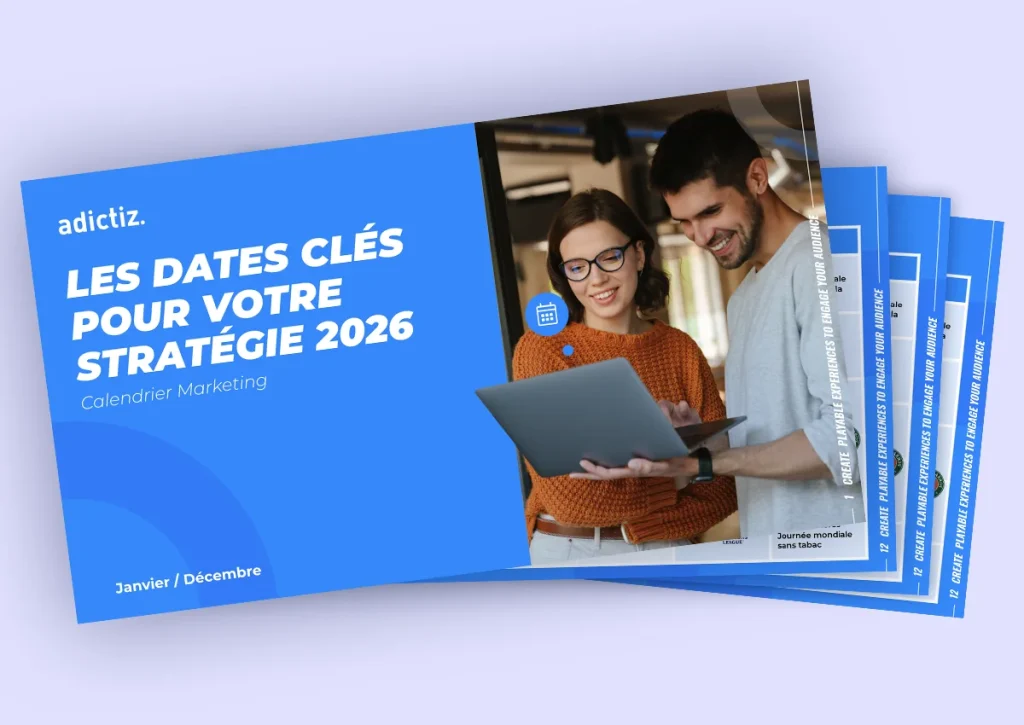Static marketing is a thing of the past.
Consumers now aspire to be able to connect with brands, submit ideas, interact with their content or participate in the creation of their future products.
As a result, traditional one-way strategies don’t work as well as they used to. These are brands that opt for interactive marketing to engage their audience, create a real bond with their community and build customer loyalty.
In this article, we share with you the keys to interactive marketing. We also explain which levers to use and which strategy to put in place to boost brand awareness and maximise conversions.
What is interactive marketing?
We’re not telling you anything when we say that capturing consumers’ attention has become the hobbyhorse of marketing professionals. This is all the more true when you consider that every day.., the average person is exposed to over 1,200 advertisements.
As a result, attracting the attention of your target audience has become increasingly complex. To engage consumers who are bombarded with advertising messages, companies need to stand out from the crowd.
And that’s where interactive marketing comes in.
Interactive marketing is a strategy that involves engaging your audience by inviting them to interact with your content in a fun way. It is not a one-way communication (like a TV ad or a promotional publication on social networks), but a two-way dialogue between the brand and its audience (prospects and customers).
The different types of interactive marketing
In theory, the definition of interactive marketing is very broad and can encompass numerous levers/media. To better understand what it’s all about, it’s therefore more interesting to go into practice with concrete examples of interactive campaigns.
Brands that opt for interactive marketing can use several types of formats:
A sports video competition to challenge game fans
Marketing games are interactive by nature. They allow you to engage your audience by encouraging them to take part in a competition to win gifts and benefits. To do this, they can take a quiz, complete a test or simply throw a one-armed bandit. C’est aussi un excellent moyen de collect first party data (via the participation form).
Launch a poll or survey
Another excellent way of engaging your audience is to ask them questions or ask for their opinion. Polls and surveys allow you to start a discussion with your consumers and find out more about their habits and expectations.
This customer feedback will be extremely valuable for redirecting their offer, improving their shopping experience, etc. For example, companies can activate this data by personalising their mailings according to the responses given by their audience.
Encourage the creation of UGC (User Generated Content)
Brands can also engage their audience by encouraging them to create content around their product and then share it on their own communication channels. UGC is not only an excellent way of enhancing the value of your customers, but also of generating reliable and authentic content, ideal for gaining visibility and animating your community.
Sharing playable ads
Unlike traditional advertising, playable ads are interactive and playable. This is what makes them stand out in today’s advertising landscapewhich is becoming increasingly saturated. The person viewing the ad will be able to take part in a marketing game to discover a new product or win a gift.
The interactive format is ideal for engaging your audience by adding CTAs directly into the video to encourage them to discover a product sheet, for example.
Personalised content and interactive storytelling
Consumers like to feel valued by brands. And personalisation is an excellent way of showing them that they are heard and understood. The simple act of sending an email to a recipient (mentioning their first and last name) can be a form of interactive marketing.
The first-party data collected through marketing games is also a good way of personalising your e-mailing or creating an interactive brand story, incorporating comments, testimonials and opinions from your customers.
What are the advantages of interactive marketing?
Interactive marketing offers a number of advantages:
Greater visibility and brand awareness
Creating fun and original interactive content gives your company a positive, unique and modern aura. According to a recent study by Ion Interactive, interactive content increases retention of the commercial message by 79% compared with static content.
Greater audience engagement
Interactive content creates a unique experience that makes the relationship between the brand and its customers both more fun and more rewarding. Consumers are not only encouraged to act (by taking part in a game or producing content, for example), usually in exchange for rewards. But above all, they feel listened to and have a sense of participating in the company’s activity.
Greater brand loyalty
Consumers are more loyal to brands whose values and message are aligned with their own. By creating an experience that is both personalised and lively, companies that rely on interactive marketing will be able to increase their website retention rate.
Instant feedback
Interactive marketing allows you to evaluate in real time how your audience interacts with your content. By responding to a survey or publishing UGC (such as a crash test or review, for example), consumers can more easily share what they think of a company, enabling it to quickly improve what needs to be improved.
Getting started in interactive marketing
To get started with interactive marketing, we recommend that you :
- Defining your target audience: this is an essential step in directing your interactive marketing strategy towards the right content format, but also towards the best distribution channels;
- Identify the triggers or the specific action to be takenthat the prospect will have to complete to start the interactive process. This could be a marketing game, a competition on social networks or even a chat window on their website.
- Determine the expected response. For example, the company may want to encourage its audience to sign up for its newsletter or generate traffic to its online shop. In this case, the interactive content and CTA should be geared towards this goal.
- Evaluate the impact of your interactive campaign. Determine the KPI’s to monitor to find out whether customers are reacting as expected and whether the interactive marketing strategy is really effective in maximising conversions or boosting visibility.
- Adjust and optimise your interactive marketing strategy. The brand can then make improvements to its interactive content based on the data collected. Ultimately, it will also be able to automate or optimise its campaigns to increase their effectiveness and profitability.
Want to get started with interactive marketing? Discover our different interactive formats to engage your audience and create a unique bond with your prospects.







